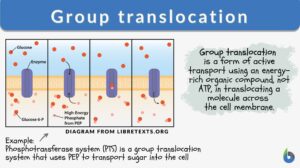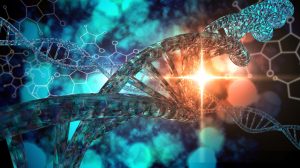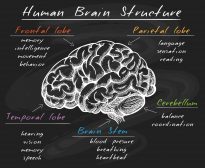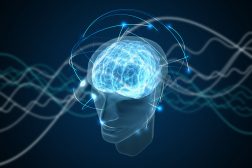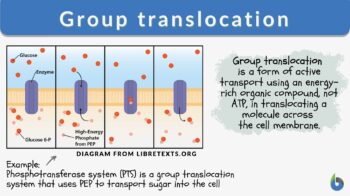
Group translocation
n., plural: group translocatios
[ɡɹuːp ˌtrænzləʊˈkeɪʃən]
Definition: transporting while transforming molecules across membranes
Table of Contents
Group Translocation Definition
Just like your “home” is a private place where you and your comfort are maintained due to the barrier of “walls” from the outside world, while simultaneously allowing wilful in-&-out movements via “gates”, similarly a biological “cell” whether it be prokaryotic or eukaryotic likes to maintain its privacy (integrity and wholesomeness) by having a barrier of “cell membrane” and permitting simultaneous movements via “protein channels and ion channels”.
Now think of a magical time machine gate, through which if you pass, not only do you exit home and enter the external world but also get transformed into another different personality!! How cool would that be? Won’t it be…??? Yeah, that’s how any molecule undergoing group translocation feels… So, when asked what group translocation is, we can tell that it’s a biological mechanism of transporting and transforming the molecules “at the same time”.
Group translocation is a biological mechanism of transporting and transforming the molecules at the same time. It is utilized by bacteria to transport a compound into their cell by first allowing the compound to bind with protein on the cell surface followed by altering its chemical structure during its passage across the membrane.Example:
An example is PEP group translocation or the phosphotransferase system, which is a distinct method used by bacteria for sugar uptake where the source of energy is from phosphoenolpyruvate.
Group translocation is a biological process where a molecule crossing the cell membrane not only gets transported but also gets transformed in itself. This is like a whole character “lift-up” for the molecule and its properties, nature, and functions get changed.
When asked whether the group translocation is active or passive, we can tell it’s active. There is a phosphorylation step associated with group translocation. Phosphate-phosphate bonds are high-energy bonds and when a phosphoryl group is released; it’s accompanied by a high amount of energy release! Instead of an ATP molecule being a regular phosphate group donor, here, an energy-rich “organic compound” is the phosphate group donor.
When asked where group translocation occurs, we can tell it occurs in the cytoplasm when a substrate is being translocated across the cell membrane. To pass across the cell membrane, a chemical modification is made in the substrate (phosphorylation, cleavage, folding, etc).
Group Translocation Examples
There are many different types of group translocation in microbiology systems like:
- Phosphotransferase system (PTS system)
- Twin-arginine translocation pathway (TAT system)
PTS
PTS or the phosphotransferase system is a group translocation system present in bacteria that aids in the uptake of sugar. Not only does the sugar molecules are transported from the extracellular space to the bacterial cell but also get modified. The modification is the “phosphorylation” of the sugar! PTS in microbiology is fairly common. Although not all bacterial species have PTS but those that have it, have different types of PTS (different types of enzyme constitutions, make-ups, enzyme conjugations, etc.) depending upon the location of the bacteria. Nearly 3.2% of the bacterial genes code for PTS group translocation proteins. (Source: Barabote, 2005)
- Source of energy: Phosphoenolpyruvate (PEP). Hence, it’s also called the PEP group translocation.
- Discovery: Saul Roseman, Kundig and Ghosh in 1964 in E.coli
- Group being transported and transformed: Glucose
- Type of transformation: Phosphorylation
- Source of -phosphoryl group: Phosphoenolpyruvate (PEP)
- Components involved:
- Enzymes of the plasma membrane as well as cytoplasm
- Enzymes of cytoplasm: EI, EIIA, EIIB, HPr (Heat-stable Histidine protein)
- Enzymes of plasma membrane: IIC
- Type of transport: Group translocation is active transport (an energy-coupled mechanism)
- Roles: When asked why is group translocation important? The following roles can be stated:
- Transportation of various sugars, like mannose, glucose, fructose, mannitol, lactose, cellobiose, chitobiose, etc., and translocation involves 4 PTS enzymes
- Regulation of carbon metabolism and nitrogen metabolism in bacteria with respect to sugar availability
- Acts as a chemoreceptive system aiding in bacterial translocation and motility towards sugar concentrated environment
- Helps in the regulation of other non-PTS enzymes
- General channel of phosphoryl group transfer: PEP → EnzymeI → Heat-stable Histidine Protein → Enzyme IIA → Enzyme IIB → Enzyme IIC
- Overall change: GlucoseàGlucose-6-phosphate
- Pros: Glucose once transformed to Glucose-6-phosphate can’t escape the cell and is the bacterium’s way to concentrate and store glucose inside its body.
- Occurrence: Group translocation occurs majorly in bacteria, less common in Archaebacteria, and absent in plants and animals.
- Examples: Escherichia coli, Salmonella enterica, Bacillus subtilis, Streptomyces spp., Listeria monocytogenes, etc.
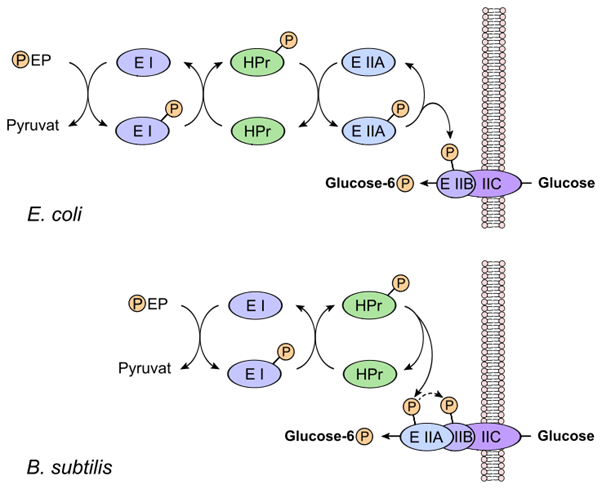
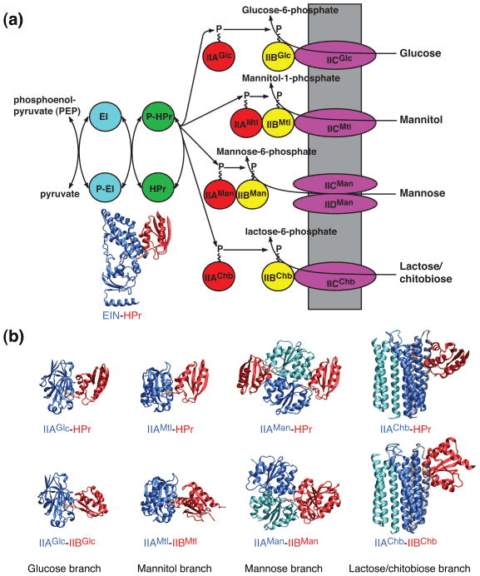
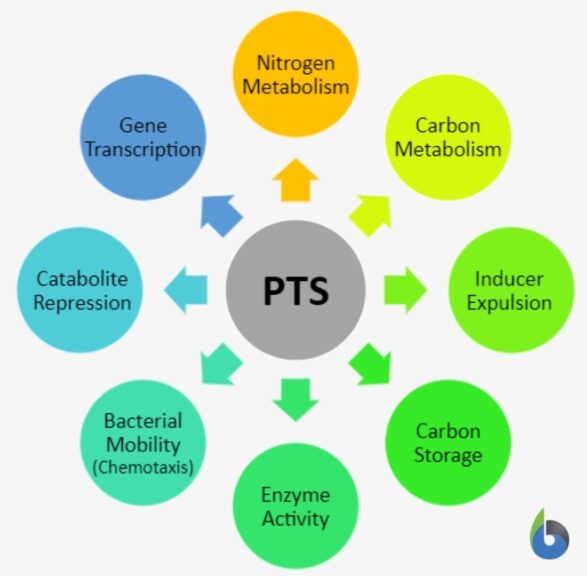
TAT System
TAT or twin-arginine translocation pathway is another group translocation pathway that helps in the transport of “properly-folded” proteins across the membranes of both prokaryotes and eukaryotes. It is named so because of the presence of a twin-arginine sequence (S/TRRXFLK). Not all bacterial species witness the presence of the TAT system. It is significantly different from Sec Pathway since it is capable of translocating “folded proteins” while the Sec pathway can only transport “unfolded proteins”.
- Found in: Plants, animals, bacteria
- Role: Transport of folded proteins/ protein secretion
- Mode of transport: Active (energy-coupled mechanism)
- Location in bacterial cells: Bacterial cytoplasmic membrane
- Location in plant cells: Chloroplasts’ thylakoid membrane
- Main constituents: 3 major proteins (TatA/B/C)
- Role: Major role in virulence of pathogenic bacteria
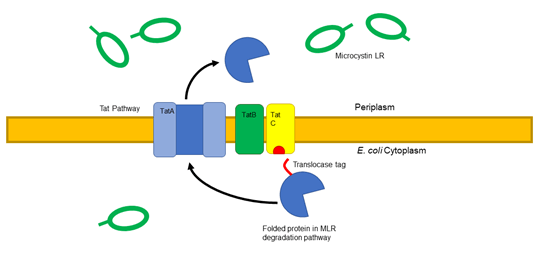

Interesting Fact
Ruminant organisms have 2 guts as they feed on solely plant-based options which are high in cellulose and lignin content. It has been seen that their foregut is the “site of rumination” where the cud (fermented ingested food which is chewed over again!) is stored. The ruminant bacteria in the rumen of these organisms have shown a wide array of PTS group transporters!!! So, can you guess why there’s a need for such a huge diversity of PTS transporters? Ponder over this…
This is an adaptation of ruminant bacteria residing in these animals’ rumens to maximize their nutrient sources. This bestows the bacteria with the ability to digest as many sugar sources as the host organism consumes. So, no matter what cow feeds on, if the PTS diversity of the ruminant bacteria residing in cow’s rumen is HIGH, anything can be a source of energy; whether it be glucose, mannose, fructose, lactose, mannitol, cellobiose, etc 😊
(Source: Barabote, 2005)
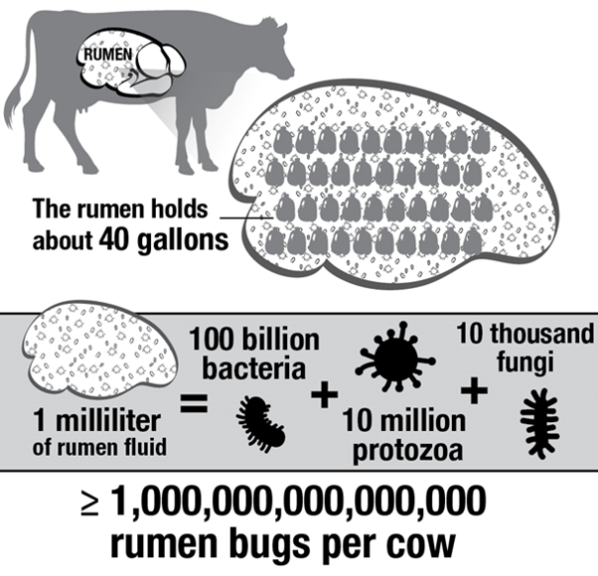
Try to answer the quiz below to check what you have learned so far about group translocation.
References
- Saier M.H., Shlykov M.A. (2012) Group Translocation – PEP:PTS https://doi.org/10.1002/9780470015902.a0001423.pub2
- Clore G.M., Venditti V. (2013). Structure, dynamics and biophysics of the cytoplasmic protein-protein complexes of the bacterial phosphoenolpyruvate: sugar phosphotransferase system. Trends in biochemical sciences, 38(10), 515–530. https://doi.org/10.1016/j.tibs.2013.08.003
- Tchieu J.H., Norris V., Edwards J.S., Saier M.H. (2001). The complete phosphotransferase system in Escherichia coli. Journal of molecular microbiology and biotechnology, 3(3), 329–346. PMID: 11361063
- Jeckelmann, J. M., & Erni, B. (2019). Carbohydrate Transport by Group Translocation: The Bacterial Phosphoenolpyruvate: Sugar Phosphotransferase System. Sub-cellular biochemistry, 92, 223–274. https://doi.org/10.1007/978-3-030-18768-2_8
- Vadeboncoeur C., Pelletier M. (1997) The phosphoenolpyruvate: sugar phosphotransferase system of oral streptococci and its role in the control of sugar metabolism, FEMS Microbiology Reviews, 19(3): 187–207. https://doi.org/10.1111/j.1574-6976.1997.tb00297.x
- Deutscher, J., Francke, C., Postma, P. W. (2006). How phosphotransferase system-related protein phosphorylation regulates carbohydrate metabolism in bacteria. Microbiology and molecular biology reviews: MMBR, 70(4), 939–1031. https://doi.org/10.1128/MMBR.00024-06
- Barabote, R. D., Saier, M. H., Jr (2005). Comparative genomic analyses of the bacterial phosphotransferase system. Microbiology and molecular biology reviews: MMBR, 69(4), 608–634. https://doi.org/10.1128/MMBR.69.4.608-634.2005
- Carrie C., Weibenberger S., Soll J. (2016). Plant mitochondria contain the protein translocase subunits TatB and TatC. Journal of Cell Science, 129 (20): 3935–3947. doi:10.1242/jcs.190975
©BiologyOnline.com. Content provided and moderated by Biology Online Editors.

